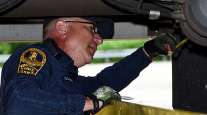Features Editor
Standard Sought for Brake Lining Classification

[Find the latest in equipment & maintenance: Explore this quarter's issue of Calibrate]
In 1995, American Trucking Associations’ Technology & Maintenance Council created a recommended practice (RP) for the classification of aftermarket brake lining materials. The hope was to create a standard that fleet managers could use, backed by dynamometer testing data results provided by brake manufacturers.
Thus, RP 628 was created, along with a list of approved aftermarket requirements of the original equipment Federal Motor Vehicle Safety Standards 121 that were carefully inspected, audited and confirmed for publication. However, after laying a procedural foundation nearly 30 years ago, the practice has lulled in interest and introspection.
“A few things have happened. Fleet interest seems to have waned. Fleets don’t seem to be looking at the RP, and we can see that through the declining participation of suppliers in the approved supplier list,” said Ron Moody, former chief engineer-mechatronics at Haldex Brake Products, during a task force session at the TMC Annual Meeting & Transportation Technology Exhibition in February. He is vice president of research and development-Americas with SAF-Holland Inc.
Moody noted that when the RP was created, 117 lining materials from 17 different suppliers were submitted to the task force. Now, only a handful of linings are under the approval process.
More Q2 Calibrate
►Standard Sought for Brake Lining Classification
►Freeze: Participating in the Right to Repair Debate
►Fleets Weigh Lift Equipment
►5 Questions With Rig Runner's Jay Rincker
►Baxter: New Oil Standard Will Help Fleets
►TMC Corner: The Evolution of Tractor-Trailer Connectivity
Explore the Issue!
Veteran brake industry professional Jim Clark was the TMC task force chairman as well as the committee chair at the Performance Review Institute during the creation of RP 628 and its updates. Now retired, and president of Vehicle Brake Systems Consulting, Clark recalled the main principles of the practice.
“It addresses three things. It addresses the torque output of the brake lights, which is stopping of the vehicle, which is the first thing that brake lines have to do; that’s most important,” he said. “The second thing is compatibility: tractor-to-trailers; and finally brake fade performance.”
Clark added that there are no federal regulations for brake lining classification, noting that the strength of the practice comes from the participation and input of all parties. He stressed the design of the RP is to create a quantifiable industry standard so fleet managers can properly address concerns to their suppliers.
“[From the approved suppliers list, fleet managers] can go to their supplier and say, ‘What is your testing standard or parameters? I want to compare,’ ” Clark said. “That way, it’s an apples-to-apples-based comparison that gives you those parameters.”

RP 628 aims to bring a quantifiable comparison to brake testing data. (Federal Mogul Motor Parts, Haldex)
However, Clark added, while some OEMs and aftermarket providers go through the testing process — dynamometer and stopping, others provide limited testing, primarily due to costs.
So, how do fleets managers distinguish between quality and lesser-based materials in brake linings?
Suggested Changes to the Recommended Practice
During a task force session at the TMC Annual Meeting & Transportation Technology Exhibition, Jim Clark shared his thoughts on improvements to RP 628:
- End the five-year deadline: “Eliminate that obsolescence,” he said. “(For instance,) double-check your supplier in five years, and make management sign a certification that they haven’t changed the formula, or moved the plant.”
- Simplify the RP: “It has become complicated. There are currently four methods of certification,” Clark said. “One of them is the vehicle test. Aftermarket line suppliers aren’t doing that test. So, we are down to three. We need to simplify the wording.”
- Update the RP: “There is a reference to the stopping distance in 2011, but most vehicles are 12 years old,” he said. “That just confuses people. Take it out. We don’t need that anymore.”
- New categories: “The air discs don’t use the same air chamber sizes,” Clark noted. “We need to clarify that so that when you put on a pad, you know what your chamber sizes are. It will reduce that chance for incompatibility and problems with high-temperature applications.”
- Create a separate RP: “If there is enough interest, we can actually create an RP for line wear. We got the PRI system, we got standardized parameters and certified dynamometers,” Clark noted. “If you really want to be able to compare the wear lines, the PRI group will run the test and then you’ll be able to see the different wear characteristics of those lines.”
- Bring the fleets to the table: “We need more fleet guys on this task force. Do you have any interest at all?” he asked. “We need more guys to represent your share of this whole thing.”
From his discussion with fleets, Michael Konrad, sales and marketing manager at Bremskerl North America, said the primary concerns fall into three categories.
“Of course, they are worried about safety, and that’s dependent on what they are asking for; whether it’s dynamometer testing or they want to do their own field testing,” he said adding the second concern is the fear of acquiring unsatisfactory friction materials. Konrad noted that third point is based on cost. “Some fleets are price-driven, ‘What does it cost me today?’ ” he explained.
Kevin Moseman, regional maintenance director for Crete Carrier Corp., cited the importance of friction material choice for fleets, especially with older trucks. For instance, in terms of comparing dynamometer and vehicle stopping distance tests, there could be varying degrees of difference in data, such as temperature testing.
“One of my concerns (in reviewing RP 628), is that I think it’s just important for all of us to get more information and the correct information, in case the data that is sitting there is based on a high temperature and may not be right,” he said. “I just want to make sure that we focus on the right statements and that fleet participation is really important.”
More specifically, as Matthew Karich, engineering manager at Hendrickson, noted, some fleet managers should take into account several considerations such as the wear of the disc pad, drum brake shoes and rotors. He added it does not serve a fleet well to apply primary focus on testing data off of one aspect more than others.
“My concern is that you give yourself a false sense of equivalency when you only look at torque,” he said.
Karich added that he liked the spirit of RP 628; however, an attempt to cover all considerations when all fleet managers have their own unique concerns could turn cumbersome.
“There are so many different factors related to how do you make something so complicated like friction so easy to digest,” he said. “I have no good answer to give that information a little better.”
Aside from fleet considerations, OEMs today are wary of sharing their proprietary information that in some cases may be privy to other competitors. With that in mind, updates to RP 628 were made several years ago, but the diminished participation remains.
“There is a great divergence of opinion as to what the motive and intentions are of all the players in this game,” said TMC Executive Director Robert Braswell. “Some people think the OEM is just going to stonewall. And other people say no ... it’s about making sure the stuff is as safe as it could be. The truth lies in middle.”

When acquiring brake parts, most fleets cite safety as their top concern. (Ryder)
During the origination of RP 628, Clark recalled, the perspective was slightly different.
“There was a lot of interest when it first came out. It was a competitive thing between the suppliers,” he said. “Then, the push came from the fleets, and subgroups like the U.S. Post Office. They responded to the articles about no regulation in the aftermarket.”
Clark reiterated that it is the fleets that need to push the OE and aftermarket supplier base once again, especially in a time of innovation with the emergence of copper-free lining testing and different air chamber sizes for disc brakes, for instance.
“That is the only way you know that the brakes on that vehicle are similar to the original equipment,” he explained. “That’s where the pressure will come from. That’s what needs to happen.”
Want more news? Listen to today's daily briefing below or go here for more info:





